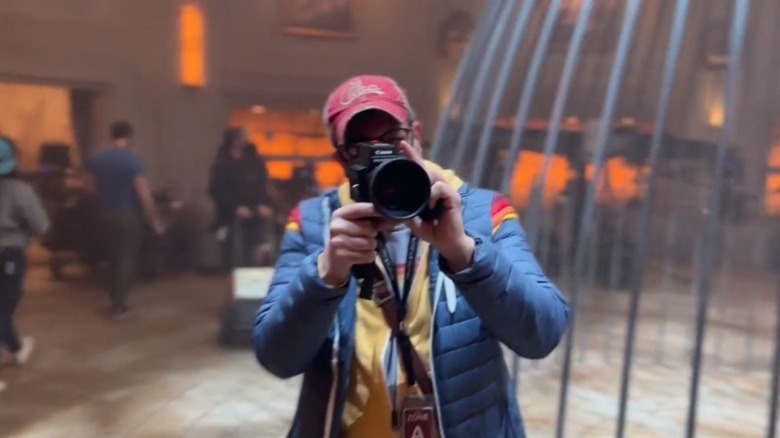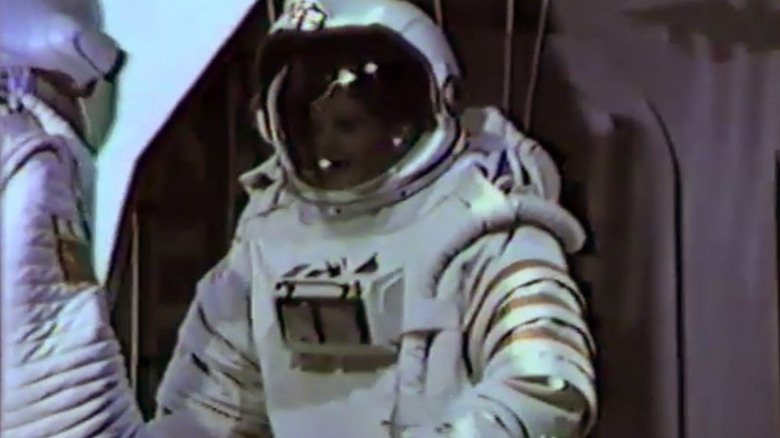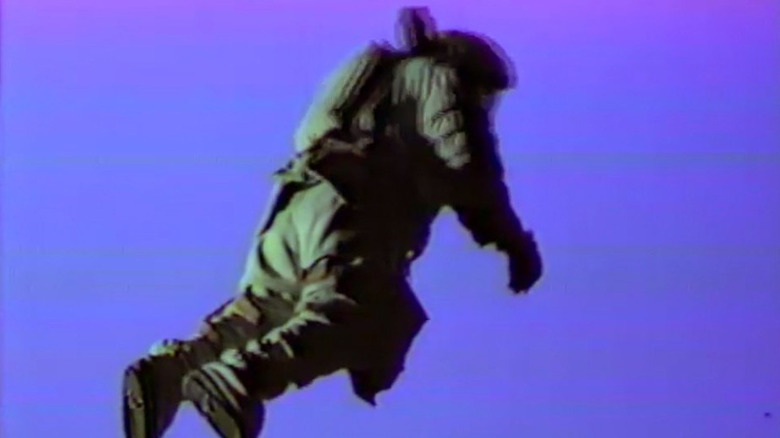Michael Giacchino's Filmmaking Origins Go All The Way Back To An Old Universal Studios Theme Park Attraction
There is an adorable moment in Anthony Giacchino's "Director by Night" — a 54-minute documentary on the amateur-turned-professional directing career of his brother Michael — where the Giacchinos' mother Josephine is asked to read a list of her famous son's composing credits. Looking over a paragraph penned by Anthony, Josephine reads that Michael has composed music for films like "The Batman" and "The MCU Spider-Man Trilogy." Innocently, she asks what "MCU" stands for. Anthony patiently explains that it describes the Marvel Cinematic Universe. Josephine then asks if "The Batman" is also part of the MCU. Anthony can barely disguise his frustration. No, mom. That's DC comics. Josephine is a little embarrassed that she's not as familiar with this stuff as her kids.
"Director by Night" isn't so much about the making of Michael's MCU entry "Werewolf by Night" (which broadcast on Disney+ on October 7), but about Michael Giacchino's childhood passion for filmmaking. Thanks to extensively archived videocassettes, audiences can witness the amateur action/adventure films that the Giacchinos made with their friends back in high school in the mid-1980s. Michael directed, and his films frequently featured sword fights and laser gun battles (the lasers were added by laying down the physical film strip and scratching laser beams directly into the emulsion).
Dispatches from the set of "Werewolf by Night" are kept mercifully brief, and Giacchino is not interviewed about the character or his film's place in the MCU. Instead, the audience is treated to wave after wave of nostalgia, with the Giacchinos reuniting with their old high school friends to reminisce running around New Jersey throwing M-80s into swimming pools and filming it.
Screen Test Comedy Theater
"Director by Night" indicates that a significant catalyst for Michael Giacchino's passion for filmmaking started when they came to Los Angeles and visited Universal Studios Hollywood. In the 1980s, Universal Studios was more "movies in general" oriented, and less concerned with massive worlds built around recognizable commercial products. Long before the days of Minion Land and Wizarding Worlds, one would take the greatest possible thrill from watching an animatronic "Jaws" shark, Bruce, pop out of the water near their tour bus. Universal Studios also featured effect-based 20-minute stage productions, animal acts, and stunt spectaculars.
One of the more thrilling attractions at Universal was called the Screen Test Theater.
For Screen Test Theater, audiences would gather on an ersatz soundstage and volunteers would be picked out of the audience to "perform." The volunteers would be hustled backstage, put into costumes — astronauts, cowboys, lovers, etc. — and given rudimentary directions. Video cameras would then, with only one take, film the actors performing. The footage would then be edited together with pre-existing footage so that the guests could be seen acting opposite the likes of Jack Lemmon. An additional pre-existing scripted audio would also be edited in so that the guests didn't even have to speak. The "film" ended with the actors having a pie fight, and Bruce received a pie-in-the-face. The "stars" could then buy the videocassette for a considerable sum.
Michael Giacchino visited Screen Test Theater twice in one visit to Universal Studios. He was clearly bitten by the filmmaking bug.
A brief history of Screen Test Theater
In the 1980s, Screen Test Theater was a more generic experience, with broad comedy and adventure films serving as the basis. In the 1970s, the experience was a little more specialized. One of the bigger genres of the 1970s was large-scale disaster movies, many of them following in the footsteps of George Seaton's "Airport." That film spawned three sequels throughout the decade, with George Kennedy appearing in all of them.
To cash in on the "plane crash" craze, Universal launched "Airport '77," a broad re-enactment of the genre's tropes with guests participating. "Actors" would sit in a re-created airplane set and get to dramatically escape as it flooded with water.
In the 1990s, after the "comedy theater" trappings fell out of vogue, Star Trek Adventure took its place. In Star Trek Adventure, audience members were dressed in Starfleet uniforms or as Klingons and reenacted a starship battle. Given the extensive costumes, makeup, and actual use of dialogue — "actors" had to read lines in the Klingon language — mistakes were frequent. This writer recalls seeing the actor playing the Klingon "pet" losing his mask and having to enact the scene with his face exposed. It was a little odd seeing a Klingon captain keeping a 10-year-old on a leash. The mistakes, however, were part of the charm, and when volunteers giggled or failed, it was incorporated into the fabric of the act.
When consumer-grade video cameras became more and more common, however, the appeal of Screen Test Theater waned rapidly. When cameras became standard issue features on cellular phones, and anyone could shoot a movie anytime, the re-enactment features at Universal died out completely.
There was, however, a time when such chintzy attractions could inspire future filmmakers.


